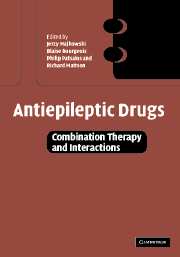Book contents
- Frontmatter
- Contents
- List of contributors
- Foreword
- Foreword
- Acknowledgements
- Part I Introduction
- 1 Combination therapy of diseases: general concepts
- 2 Combination therapy with antiepileptic drugs: potential advantages and problems
- 3 Pharmacogenetic aspects
- Part II Pharmacokinetic interactions
- Part III Pharmacodynamic interactions
- Part IV Drug interactions in specific patient populations and special conditions
- Part V Conclusions and future perspectives
- Index
2 - Combination therapy with antiepileptic drugs: potential advantages and problems
from Part I - Introduction
Published online by Cambridge University Press: 07 September 2009
- Frontmatter
- Contents
- List of contributors
- Foreword
- Foreword
- Acknowledgements
- Part I Introduction
- 1 Combination therapy of diseases: general concepts
- 2 Combination therapy with antiepileptic drugs: potential advantages and problems
- 3 Pharmacogenetic aspects
- Part II Pharmacokinetic interactions
- Part III Pharmacodynamic interactions
- Part IV Drug interactions in specific patient populations and special conditions
- Part V Conclusions and future perspectives
- Index
Summary
Rationale for combination therapy
Antiepileptic drug (AED) treatment of epilepsy to prevent or minimize recurrent epileptic seizures begins with the use of a single agent as monotherapy. The primary reason why two or more drugs are used together is the failure of monotherapy to control the seizures. Depending on the type of seizures and epilepsy syndrome, control may be complete or very poor. In adult-onset seizures control varies between 35% and 60% for partial seizures and 10% and 20% higher for tonic–clonic seizures after 1-year follow-up (Mattson et al., 1985, 1992, 1996; Richens et al., 1994; Heller et al., 1995; Kwan and Brodie, 2000). The long-term response is less favorable for some patients because breakthrough seizures occur over time although others enter remission (Richens et al., 1994; Heller et al., 1995). Seizures associated with idiopathic generalized epilepsies are usually more easily controlled.
When seizures continue despite increasing doses of the initial AED to the maximum that can be tolerated, a second drug is usually added to the first in an effort to achieve better control. In those patients with particularly refractory seizures/epilepsy, three and even four AEDs are occasionally employed. The overall indications for and selection of combined therapy as well as the associated problems encountered are issues of importance.
When initial monotherapy fails to provide adequate seizure control despite being optimally given, an alternative AED is added and, when possible, is titrated up gradually. Dose increases are made as tolerated and as needed to obtain control.
Keywords
- Type
- Chapter
- Information
- Antiepileptic DrugsCombination Therapy and Interactions, pp. 16 - 25Publisher: Cambridge University PressPrint publication year: 2005
- 1
- Cited by



